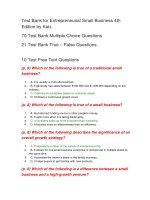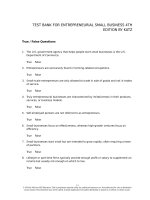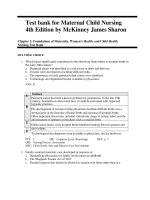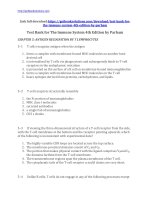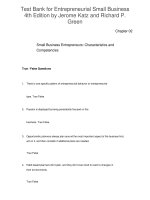101 test bank for entrepreneurial small business 4th edition by katz
Bạn đang xem bản rút gọn của tài liệu. Xem và tải ngay bản đầy đủ của tài liệu tại đây (122.21 KB, 25 trang )
Test Bank for Entrepreneurial Small Business 4th
Edition by Katz
70 Test Bank Multiple Choice Questions
21 Test Bank True – False Questions
10 Test Free Text Questions
(p. 9) Which of the following is true of a traditional small business?
1.
2.
A. It is usually a multi-site business.
B. It generally has sales between $100,000 and $1,000,000 depending on the
industry.
3.
C. It defines its schedules based on customer needs.
4.
D. It follows a continuous growth curve.
(p. 8) Which of the following is true of a small business?
1.
A. Its preferred funding source is other people's money.
2.
B. It sells more when it is facing bankruptcy.
3.
C. It considers sales as more important than marketing.
4.
D. It focuses more on effectiveness than on efficiency.
(p. 8) Which of the following describes the significance of an overall
growth strategy?
1.
2.
A. It represents a driver of the variety of entrepreneurship.
B. It allows for one small business enterprise to incorporate in multiple states at
the same time.
3.
C. It provides the owner a stake in the family business.
4.
D. It helps buyers to get familiar with new products.
(p. 8) Which of the following is a difference between a small business and
a high-growth venture?
1.
A. For a small business, the preferred funding source is other people's money,
whereas for a high-growth venture, it is the owner's own money.
2.
B. For a small business, the personal control preference is to involve others,
whereas a high-growth venture prefers to retain autonomy.
3.
C. A small business focuses on effectiveness, whereas a high-growth venture
focuses on efficiency.
4.
D. A small business grows when necessary, whereas a high-growth venture grows
when possible.
(p. 9) _____ are the smallest full-time business.
1.
A. High-performing small businesses
2.
B. Traditional small businesses
3.
C. High-growth ventures
4.
D. Lifestyle businesses
(p. 6) Small businesses are usually:
1.
A. imitative in nature.
2.
B. characterized by the novelty of their products.
3.
C. the same as high-growth ventures.
4.
D. not affected by market fluctuations.
(p. 10) _____ is a reward universally mentioned by entrepreneurs.
1.
A. Industry recognition
2.
B. Peer admiration
3.
C. Political power
4.
D. Work flexibility
(p. 8) Which of the following is an attribute of a high-growth venture?
1.
A. Its preferred funding source is the owner's own money.
2.
B. Its metastrategy is imitation.
3.
C. It grows when necessary.
4.
D. It considers delegation essential.
(p. 7) A person who becomes an owner by inheriting or getting a stake in a
family business is known as a _____.
1.
A. founder
2.
B. franchisor
3.
C. heir
4.
D. serial entrepreneur
(p. 10) The ability of business owners to structure their lives in the way
that best suits their needs refers to:
1.
A. flexibility rewards.
2.
B. family rewards.
3.
C. growth rewards.
4.
D. wealth rewards.
(p. 10) _____ rewards are those which people get from facing and beating
or learning from challenges.
1.
A. Recognition
2.
B. Flexibility
3.
C. Income
4.
D. Growth
(p. 10) Which of the following is a reward universally mentioned by
entrepreneurs?
1.
A. Peer admiration
2.
B. Personal growth
3.
C. Political power
4.
D. Industry recognition
(p. 10) Tina runs her consultancy business from her home. Working from
home allows her to set her own schedule and take time off at her
convenience so that she can be with her family. The fact that Tina gets
more time with her family can be categorized as ______ reward.
1.
A. income
2.
B. flexibility
3.
C. growth
4.
D. credit
(p. 8) Which of the following is a characteristic of a lifestyle firm?
1.
A. It starts small and grows very rapidly to become a big business.
2.
B. It represents about 20 percent of all businesses.
3.
C. It typically has sales of $25,000 a year or less.
4.
D. It aims to achieve growth rates of 25 percent or more a year.
(p. 9) _____ tend to level off after success defined by sales of between
$100,000 and $1,000,000, depending on the industry.
1.
A. Lifestyle firms
2.
B. Traditional small businesses
3.
C. High-performing small businesses
4.
D. High-growth ventures
(p. 8) Which of the following is true of a part-time firm?
1.
A. It starts small and stays very small.
2.
B. It has a continuous growth.
3.
C. Its success is defined by annual profits of $1,000,000.
4.
D. It aims to achieve growth rates of 25 percent or more a year.
(p. 5) The _____ is a U.S. government agency that helps people start a
business and also provides them support and advocacy.
1.
A. Small Business Administration
2.
B. U.S. Department of Business Development
3.
C. U.S. Department of Commerce
4.
D. U.S. Entrepreneurial Administration
(p. 10) Which of the following rewards refer to the money made from
owning a business?
1.
A. Growth rewards
2.
B. Flexibility rewards
3.
C. Income rewards
4.
D. Performance rewards
(p. 8) High-growth ventures:
1.
A. use imitation as their metastrategy.
2.
B. start small but are intended to grow rapidly.
3.
C. cannot include a team of partners.
4.
D. do not delegate tasks.
(p. 8) Which of the following is true of a high-growth venture?
1.
A. It considers sales as more important than marketing.
2.
B. Its metastrategy is novelty.
3.
C. It focuses more on efficiency than on effectiveness.
4.
D. It does not allow for easy delegation of work or responsibilities.
(p. 6) Truly entrepreneurial businesses are characterized by:
1.
A. the franchise they are associated with.
2.
B. the degree to which their products are imitative.
3.
C. the novelty in their products, services, or business models.
4.
D. the ease with which their product is accepted by the buyers.
(p. 7) Which of the following is true of a franchise?
1.
A. It is the international term for all small businesses.
2.
B. It is a type of novelty organization.
3.
C. It is an organization that provides loans to start small businesses.
4.
D. It is a prepackaged business bought, rented, or leased from a company.
(p. 7) A business run by the individual who owns it is referred to as a(n)
_____.
1.
A. franchise
2.
B. owner-managed firm
3.
C. professionally-owned business
4.
D. novelty firm
(p. 9) Lifestyle firms, traditional small businesses, and high-performing
small businesses are often called _____.
1.
A. main street businesses
2.
B. Wall Street businesses
3.
C. high-growth ventures
4.
D. universal businesses
(p. 9) Which of the following is true of a high-performing small business?
1.
A. It often grows through multiple locations.
2.
B. It aims to achieve growth rates of 25 percent or more a year.
3.
C. It has sales of more than $1 million.
4.
D. It has low levels of professionalization.
(p. 9) Which of the following is a characteristic of a traditional small
business?
1.
A. It is often a one-site business.
2.
B. It follows a continuous growth curve.
3.
C. It defines its schedules based on the owner's needs.
4.
D. It generally has sales between $100,000 and $1,000,000 depending on the
industry.
(p. 8) High-growth ventures differ from small businesses in that in highgrowth ventures:
1.
A. the focus is on efficiency rather than effectiveness.
2.
B. the preferred source of funding is the owner's own money rather than other
people's money.
3.
C. the human resource system is personalized rather than professionalized.
4.
D. the limitation of growth is dictated by market response rather than the owner's
loss of control.
(p. 9) Which of the following is a characteristic of a high-growth venture?
1.
A. It pursues low levels of professionalization.
2.
B. It levels off after operations settle into a consistent, money-making pattern.
3.
C. It aims to achieve growth rates of 25 percent or more a year.
4.
D. Its success is defined by sales of between $100,000 and $1,000,000 annually.
(p. 9) Which of the following categories does the majority of small
businesses fall under?
1.
A. High-growth ventures
2.
B. High-performing small businesses
3.
C. Lifetime/Part-time firms
4.
D. Traditional small business
(p. 9) A traditional small business generally has sales of between:
1.
A. $100,000 and $1,000,000.
2.
B. $100,000 and $200,000.
3.
C. $25,000 and $100,000.
4.
D. $50,000 and $80,000.
(p. 7) A business owned by an individual or a little group is referred to as
a(n):
1.
A. corporate chain.
2.
B. conglomerate.
3.
C. concern.
4.
D. independent small business.
(p. 10) Which of the following is a reward that is rarely mentioned by
entrepreneurs?
1.
A. To have a chance to build great wealth
2.
B. To have greater flexibility for personal and family life
3.
C. To continue a family tradition
4.
D. To develop an idea for a product
(p. 8) Small businesses differ from high-growth ventures in that in small
businesses:
1.
A. the focus is on effectiveness rather than efficiency.
2.
B. the preferred source of funding is the owner's own money rather than other
people's money.
3.
C. the delegation of responsibilities is easy and necessary rather than difficult.
4.
D. the metastrategy is for novelty rather than imitation.
(p. 9) Which of the following is true of the growth of a typical traditional
small business?
1.
A. It tends to quickly level off after the owners operate long enough to learn the
basics of making money.
2.
B. It levels off after operations settle into a consistent, money-making pattern
generating income to provide a living for the owner.
3.
C. It grows at rates between 5 to 15 percent a year.
4.
D. It grows at rates of 25 percent or more a year.
(p. 8) In lifestyle firms:
1.
A. success is defined by sales of between $100,000 and $1,000,000.
2.
B. schedules are defined by customer needs.
3.
C. the income generated usually provides a living for the owner and family.
4.
D. growth tends to quickly level off.
(p. 8) Which of the following is a characteristic of a small business?
1.
A. Source of funding is primarily other people's money
2.
B. Focus is on efficiency
3.
C. Professionalized approach to human resource
4.
D. Delegation is essential
70 Free Test Bank for Entrepreneurial Small Business
4th Edition by Katz Multiple Choice Questions - Page 2
(p. 19) Virtual instant global entrepreneurship refers to:
1.
A. the transformation of a high-growth venture into a small business.
2.
B. a person becoming an owner by inheriting or getting a stake in a family
business.
3.
C. the way that newly created goods, services, or firms hurt existing goods,
services, or firms.
4.
D. a process that uses the Internet to quickly create businesses with a worldwide
reach.
(p. 13) John owns a small business that does computer servicing. Which
of the following would represent boundary as mentioned in the BRIE
model in John's computer servicing business?
1.
A. The employees that work under John
2.
B. The office in which John works
3.
C. The money earned by John from the business
4.
D. The desire to expand the business to writing software
(p. 13) According to the BRIE model, which of the following is true of a
resource?
1.
A. It includes a business name or government registration.
2.
B. It refers to moving goods or services to others for money.
3.
C. It is the most frequently occurring element of the BRIE model.
4.
D. It includes the product or service to be offered.
(p. 18) In factor-driven economies:
1.
A. entrepreneurship levels are in the middle range.
2.
B. entrepreneurship levels are very high.
3.
C. entrepreneurship levels are very low.
4.
D. entrepreneurship is not given any consideration.
(p. 11) Which of the following is a myth about small businesses?
1.
A. That failed entrepreneurs can succeed if they try again
2.
B. That a small business will never have enough financing
3.
C. That students have skills to start small businesses
4.
D. That small businesses can start during recession
(p. 20) _____ is an aspect of entrepreneurship that refers to doing the
most work with the fewest resources.
1.
A. Innovation
2.
B. Creation
3.
C. Efficiency
4.
D. Customer-focus
(p. 20) _____ is an aspect of entrepreneurship which looks at a new thing
or a new way of doing things.
1.
A. Customer-focus
2.
B. Innovation
3.
C. Creation
4.
D. Efficiency
(p. 19) In innovation-driven economies:
1.
A. entrepreneurship levels are in the middle range.
2.
B. entrepreneurship levels are very high.
3.
C. entrepreneurship levels are lower compared to factor-driven economies.
4.
D. entrepreneurship is not given any consideration.
(p. 18) A nation where industrialization is the major force providing jobs,
revenues and taxes, and where minimizing costs while maximizing
productivity is a major goal is a(n):
1.
A. factor-driven economy.
2.
B. efficiency-driven economy.
3.
C. innovation-driven economy.
4.
D. effectiveness-driven economy.
(p. 13) According to the BRIE model, which of the following falls under the
boundary category?
1.
A. The financial resources of a company
2.
B. The desire to start a business
3.
C. An e-mail address of the company
4.
D. A product or service offered by the company
(p. 12) Financing a business online through the collective involvement of
others who provide donations, loans, or investments is referred to as
_____.
1.
A. crowdfunding
2.
B. bootstrapping
3.
C. microfinancing
4.
D. crowdsourcing
(p. 20) Which of the following is true of corporate entrepreneurship?
1.
A. It involves the creation of self-sustaining charitable and civic organizations.
2.
B. It involves revitalizing government agencies.
3.
4.
C. It is a form of entrepreneurship in which people own their own for-profit
business.
D. It involves bringing new products or services to a market.
(p. 20) Social entrepreneurship primarily involves a person or group:
1.
A. creating new charitable and civic organizations which are financially selfsufficient.
2.
B. bringing new products or services to market.
3.
C. owning their own for-profit business.
4.
D. revitalizing government agencies.
(p. 19) Innovation-driven economies:
1.
A. are those where entrepreneurship becomes a key way to build the middle class.
2.
B. are nations where industrialization is becoming the major force providing jobs,
revenues, and taxes.
3.
C. are focused on high-value-added manufacturing but are marked by a very large
service sector.
4.
D. are those where entrepreneurship is essential to build personal wealth and
break the cycle of low-wage jobs.
(p. 15) In terms of new jobs, which of the following is true of a small
business?
1.
A. It does not employ people looking for part-time work.
2.
B. It is of no importance to existing jobs.
3.
C. It offers jobs to people with atypical work histories.
4.
D. It pays taxes on behalf of the people it hires.
(p. 21) Effectuation refers to:
1.
A. the degree of attention a target market pays to an idea or organization.
2.
B. an approach used to create alternatives in uncertain environments.
3.
C. transforming a high-growth venture into a small business.
4.
D. a process of a person becoming an owner by inheriting or getting a stake in a
family business.
(p. 13) According to the BRIE model, which of the following sets a firm off
from the buying or selling or bartering done casually by nonmerchants?
1.
A. Resources
2.
B. Boundary
3.
C. Intention
4.
D. Exchange
(p. 20) Which of the following types of entrepreneurship typically
concentrates on innovation and customer-focus among all aspects of
entrepreneurship?
1.
A. Public entrepreneurship
2.
B. Corporate entrepreneurship
3.
C. Independent entrepreneurship
4.
D. Social entrepreneurship
(p. 13) Which of the following is the most frequently occurring element of
the BRIE model?
1.
A. Intention
2.
B. Boundary
3.
C. Exchange
4.
D. Resources
(p. 18) A nation where the major forces for jobs, revenues, and taxes come
from farming or extractive industries like forestry, mining, or oil
production is a(n):
1.
A. factor-driven economy.
2.
B. efficiency-driven economy.
3.
C. innovation-driven economy.
4.
D. competency-driven economy.
(p. 20) _____ is the degree of attention a target market pays to an idea or
organization.
1.
A. Crowdfunding
2.
B. Effectuation
3.
C. Mindshare
4.
D. Crowdfunding
(p. 15) The way that newly created goods, services, or firms hurt existing
goods, services, or firms is referred to as:
1.
A. benchmarking.
2.
B. creative destruction.
3.
C. service distortion.
4.
D. crowdsourcing.
(p. 20) Which of the following aspects of entrepreneurship refers to being
in-tune with one's market?
1.
A. Efficiency
2.
B. Creation
3.
C. Customer-focus
4.
D. Growth
(p. 20) The form of entrepreneurship in which a person or group own their
own for-profit business is referred to as:
1.
A. independent entrepreneurship.
2.
B. social entrepreneurship.
3.
C. public entrepreneurship.
4.
D. corporate entrepreneurship.
(p. 15) Mandarin In Town, a Chinese restaurant, opened recently in
Burnsville, Minnesota. People from all over the town flocked to Mandarin
to find out how good it was. This gave a big boost to the restaurant's
initial business, but it caused the other restaurants in the area to lose
business temporarily. The way in which Mandarin in Town hurt existing
restaurants in Burnsville is an example of:
1.
A. creative destruction.
2.
B. service distortion.
3.
C. innovative disruption.
4.
D. crowdsourcing.
(p. 13) In the BRIE model, a business name or government registration, a
phone or e-mail address dedicated to the business, or a specific location
for the firm in a home, commercial space, or on the Internet represents:
1.
A. exchange.
2.
B. resource.
3.
C. boundary.
4.
D. intention.
(p. 20) Which of the following is true of social entrepreneurship?
1.
A. It usually has a lot of funding.
2.
B. It creates organizations which are usually financially dependent on other firms.
3.
C. It cannot be initiated by a for-profit company.
4.
D. It does not include innovation as a key element.
(p. 16) According to the U.S. Small Business Administration, small
businesses generate _____ times the number of patents per employee
than do big businesses.
1.
A. 35.5
2.
B. 2.5
3.
C. 16.5
4.
D. 50.5
(p. 13) Which of the following elements of the BRIE model represents the
desire to start a business?
1.
A. Intention
2.
B. Boundary
3.
C. Exchange
4.
D. Resources
(p. 18) In efficiency-driven economies:
1.
A. entrepreneurship levels are in the middle range.
2.
B. entrepreneurship levels are very high.
3.
C. entrepreneurship levels are very low.
4.
D. entrepreneurship is not given any consideration.
(p. 13) According to the BRIE model, _____ sets up a business as a firm.
1.
A. intention
2.
B. exchange
3.
C. franchise
4.
D. boundary
(p. 13) According to the BRIE model, which of the following is an element
that is necessary to start a business?
1.
A. Boundary
2.
B. Recognition
3.
C. Efficiency
4.
D. Income
(p. 12) Bootstrapping refers to:
1.
A. funding a business online through the collective involvement of others who
provide loans.
2.
B. buying, renting, or leasing a prepackaged business from another company.
3.
C. inheriting or being given a stake in a family business.
4.
D. using low-cost or free techniques to minimize the cost of doing business.
(p. 12) Anna helps brides-to-be choose wedding gowns that best suit their
requirements and budget, and also helps them with where they can find
the right dress. She has made her home her virtual office; she does not
require external financing. Anna is using _____ to run her small business.
1.
A. crowdfunding
2.
B. franchising
3.
C. bootstrapping
4.
D. crowdsourcing
21 Free Test Bank for Entrepreneurial Small Business
4th Edition by Katz True - False Questions
(p. 13) The disadvantage of the BRIE model is that it does not mention the
management of resources.
1.
True
2.
False
(p. 5) The U.S. government agency that helps people start small
businesses is the U.S. Department of Commerce.
1.
True
2.
False
(p. 10) Flexibility rewards refer to the money made from owning a
business.
1.
True
2.
False
(p. 10) Flexibility rewards are the most rapidly growing type of reward.
1.
True
2.
False
(p. 13) The most frequently occurring element of the BRIE model is
intention.
1.
True
2.
False
(p. 17) High-growth ventures and big businesses generally do not succeed
without small businesses offering supporting services.
1.
True
2.
False
(p. 18) Entrepreneurship levels are very high in efficiency-driven
economies.
1.
True
2.
False
(p. 6) Small-scale entrepreneurs are only allowed to trade in sale of goods
and not in trades of service.
1.
True
2.
False
(p. 6) Truly entrepreneurial businesses are characterized by imitativeness
in their products, services, or business models.
1.
True
2.
False
(p. 8) Lifestyle or part-time firms typically provide enough profit or salary
to supplement an income but usually not enough on which to live.
1.
True
2.
False
(p. 12) Using low-cost or free techniques to minimize cost of doing
business is referred to as bootstrapping.
1.
True
2.
False
(p. 8) Small businesses focus on effectiveness, whereas high-growth
ventures focus on efficiency.
1.
True
2.
False
(p. 20) The primary focus of corporate entrepreneurship is creating new
civic organizations which are financially self-sufficient.
1.
True
2.
False
(p. 13) One of the key elements of the BRIE model is a person's intentions
to start a business.
1.
True
2.
False
(p. 12) Ninety percent of all new businesses fail within two years.
1.
True
2.
False
(p. 5) Entrepreneurs are exclusively found in farming-related occupations.
1.
True
2.
False
(p. 8) Small businesses start small but are intended to grow rapidly, often
requiring a team of partners.
1.
True
2.
False
(p. 9) Traditional small businesses' schedules are defined by the owners'
needs.
1.
True
2.
False
(p. 7) Self-employed persons are not referred to as entrepreneurs.
1.
True
2.
False
(p. 9) High-growth ventures are also known as main street businesses.
1.
True
2.
False
(p. 13) In the BRIE model, exchange refers to moving resources, goods, or
services to others, in exchange for money or other resources.
1.
True
2.
False
10 Free Test Bank for Entrepreneurial Small Business
4th Edition by Katz Free Text Questions
(p. 9-10) Briefly describe the three universally mentioned and four rarely
mentioned rewards.
Answer Given
Nearly all entrepreneurs talk about three key rewards—flexibility, a livable income,
and personal growth. There are two other rewards—building great wealth and
creating products, which entrepreneurs mention more often than working people in
general. There are also rewards that entrepreneurs mention less often than
working people in general. These are social rewards, like the respect or
admiration of others, or power over others, and family rewards, like continuing a
family tradition in business. The three most popular types of rewards for small
business owners are growth, flexibility, and income. Growth rewards are what
people get from facing and beating or learning from challenges. Income rewards
refer to the money made from owning your own business. For more than threequarters of entrepreneurs, this means seeking to match or slightly better the
income you had before you started your own business. Flexibility rewards are
perhaps the most rapidly growing type of reward. They refer to the ability of
business owners to structure their lives in the way that best suits their needs.
(p. 19) What is VIGE? Explain.
Answer Given
One approach that has grown dramatically in the past 15 years is using
ecommerce, particularly auction sites like eBay, to handle global trade. The formal
title for this is virtual instant global entrepreneurship (VIGE). VIGE depends on
using Web sites like eBay (for products) or eLance (for services) to quickly
establish a global presence. Many of these VIGE sites offer procedures, services,
and Web page templates which incorporate best practices for global trading. The
VIGE site provides the assurance of honesty on the part of buyers and sellers,
using rules, warrantees, and most of all, mutual ratings of buyers and sellers.
(p. 15) What is the role of small businesses in creating new jobs?
Answer Given
Small business has added tens of millions of jobs. In the latest statistics, small
businesses created 65 percent of the new jobs created. Small business start-ups
in the first two years of operation accounted for virtually all the net new jobs in
America. Small business is the engine of job generation, but it is important for
existing jobs, too. Small businesses employ more than half of all Americans,
providing wages, salaries, and the taxes those working people pay the
government. Small businesses are also key employers because they are more
willing than most large businesses to offer jobs to people with atypical work
histories or needs, like people new to the workforce, people with uneven
employment histories, and people looking for part-time work. These employment
issues are at the core of what makes small business attractive to local and state
governments.
(p. 11-12) What are the most common myths about small businesses?
What are the facts that contradict these myths?
Answer Given
For years potential entrepreneurs have mentioned problems like these: 1) Not
enough financing: The SBA reports that bank financing is up from its low in early
2009, and the same is true for funding from family, friends, and angels.
Crowdfunding and bootstrapping techniques are also being discovered by
entrepreneurs; 2) It is not possible to start businesses during a recession:
Businesses started in recessions start lean—no fancy offices, no bonuses. That
means they learn from the start how to do more with less, which makes them
better able to handle future times of scarcity and trouble. According to a 2009
BusinessWeek report, seven of the ten largest companies in the 2009 Fortune 500
were started in recessions; 3) To make profits, entrepreneurs need to make
something: In 2011, amid a recession, Sageworks reported that of the 10 most
profitable industries for small businesses, 9 were services like dentists, tax
preparers, mining support services, credit counselors, insurance brokers, and
legal and health practitioners. Whereas getting a DDS or MD degree takes years
and tens of thousands of dollars, bookkeeping and credit counseling require little
specialized training; 4) If an entrepreneur fails, he or she can never try again: If
entrepreneurs close a business and pay off their debts, they did not fail. If they
learned how to do better next time, then they can honestly say they have paid for
another piece of their education. A large number of today's successful
entrepreneurs had failures along the way; 5) Students (or moms or some other
group) do not have the skills to start a business: It would be hard for an
undergraduate to open a medical practice, but lots of students have useful
business skills.
(p. 20) What are the different aspects of entrepreneurship?
Answer Given
The different aspects of entrepreneurship are: 1) Creation, which looks at the
making of new entities; 2) Customer-focus, which refers to being in-tune with your
market; 3) Efficiency, which refers to doing the most work with the fewest
resources; 4) Innovation, which looks at a new thing or a new way of doing things.
(p. 18) What is a factor-driven economy?
Answer Given
A factor-driven economy is a nation where the major forces for jobs, revenues and
taxes come from farming or extractive industries like forestry, mining, or oil
production. In these factor-driven economies, entrepreneurship is essential to
helping build personal wealth and breaking the cycle of low-wage jobs, and so,
entrepreneurship levels tend to be very high.
(p. 15) What is creative destruction?
Answer Given
Small business is a key element of every nation's economy because it offers a
very special environment in which the new can come into being. Austrian
economist Joseph Schumpeter labeled this process creative destruction. It refers
to the way that newly created goods, services, or firms can hurt existing goods,
services, or firms. For example, when a new restaurant opens in a neighborhood,
people flock to it to find out what it's like. This helps the new restaurant, but it also
causes the other restaurants in the area to lose business, at least temporarily.
(p. 13-15) Briefly describe the BRIE model.
Answer Given
In order to start a business, four elements must come together—boundary,
resources, intention, and exchange. This is referred to as the BRIE model. A
business needs the benefits of a boundary—something that sets it up as a firm,
and sets it off from the buying or selling or bartering. Having a boundary gives a
place to locate and protect the resources gathered for the business. Resources
include the product or service to be offered, informational resources on markets
and running a business, financial resources, and human resources such as the
time to devote to the business. Intention is the desire to start a business and is the
most frequently occurring element of the BRIE model. Exchange refers to moving
resources, goods, or service to others, in exchange for money or other resources.
If the firm doesn't exchange with its environment, there is no "business" taking
place. The BRIE model factors outline the activities that need to take place to get
a firm going. The BRIE model can help a prospective entrepreneur deal with one
of the biggest hurdles to starting a business. According to the experts, the biggest
problem is simply inaction.
(p. 20) What are the different forms of entrepreneurship?
Answer Given
There are three forms of entrepreneurship which are together called CSI
entrepreneurship. The three forms differ in which aspect of entrepreneurship they
focus: creation which looks at the making of new entities; customer-focus which
refers to being in-tune with your market; efficiency which refers to doing the most
work with the fewest resources; and innovation which looks at a new thing or a
new way of doing things. In independent entrepreneurship, all four elements are
essential, and that is what makes small business as important as the role model
for the other forms. In corporate entrepreneurship, the focus is typically on
customer-focus and innovation, bringing new products or services to market, or
opening up new markets to your firm. Famous examples of corporate
entrepreneurship include the creation of new brands like Apple's iPod or GM's
green energy services. Social entrepreneurship on the other hand involves
creating new charitable and civic organizations which are financially self-sufficient.
(p. 7-8) What is the difference between small businesses and high-growth
ventures?
Answer Given
Both small businesses and high-growth ventures may be small when they start.
However, small businesses are usually intended to remain small, generally a size
that the owner feels comfortable controlling personally. High-growth ventures start
small but are intended to grow rapidly, often requiring a team of partners or
managers to handle the growth. The differences between small businesses and
high-growth ventures are not just semantic, they are fundamental.

